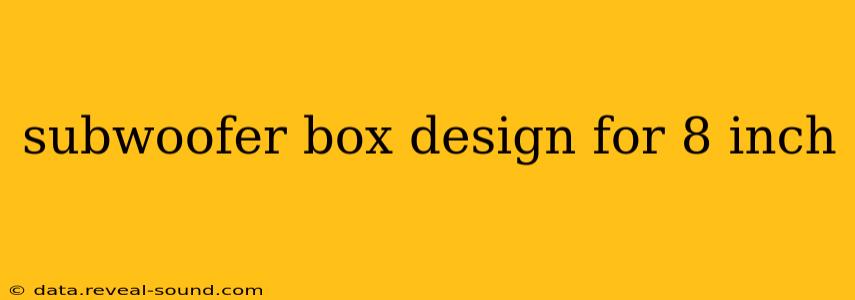Choosing the right subwoofer box is crucial for achieving optimal sound quality from your 8-inch driver. A poorly designed enclosure can severely hamper performance, resulting in muddy bass, lack of extension, or even driver damage. This guide will explore various design considerations, helping you choose or build the perfect enclosure for your 8-inch subwoofer.
What Type of Enclosure is Best for an 8-Inch Subwoofer?
The ideal enclosure type depends heavily on your desired sound characteristics and listening environment. Several popular options exist, each with its own strengths and weaknesses:
-
Sealed (Acoustic Suspension): Sealed enclosures are simple to design and build, offering tight, controlled bass with good accuracy. They're generally smaller than ported designs for the same driver but tend to produce less overall output. Excellent for smaller spaces where space is at a premium and accuracy is prioritized.
-
Ported (Bass Reflex): Ported enclosures use a port (tube) to enhance bass output by resonating with the driver at a specific frequency. They offer greater output and extension than sealed boxes, but can be more challenging to design accurately and may produce a less "tight" sound if not properly tuned. Ideal for larger rooms or those requiring higher SPL (Sound Pressure Level).
-
Bandpass: Bandpass boxes are more complex, utilizing two or more chambers to create a resonant frequency range. They offer extremely high output within a narrow frequency band but require precise calculations and are generally less versatile than sealed or ported designs. Not recommended for beginners.
-
Horn: Horn loaded subwoofers offer incredible efficiency and output, but require significant design expertise and are rarely practical for home audio applications using 8-inch drivers.
What are the Key Design Parameters?
Designing a subwoofer enclosure involves several critical parameters:
-
Internal Volume: The internal volume of the box is crucial and directly impacts the low-frequency response. This volume is typically expressed in cubic feet (ft³) or liters (L). Incorrect volume can lead to poor performance and driver damage.
-
Tuning Frequency (for ported boxes): The tuning frequency of a ported enclosure determines the frequency at which the port resonates, significantly affecting the overall bass response. This is usually calculated using specialized software or online calculators.
-
Port Length and Diameter: The dimensions of the port (length and diameter) are directly related to the tuning frequency and internal volume. Incorrect port dimensions will result in poor performance.
-
Bracing: Internal bracing helps to stiffen the enclosure, minimizing unwanted resonances and vibrations that can negatively impact sound quality.
How Do I Determine the Right Box Size for My 8-Inch Subwoofer?
Most 8-inch subwoofer manufacturers provide specifications and recommendations for ideal enclosure sizes and types. These specifications are usually found in the driver's datasheet. Pay close attention to the recommended volume ranges and the suggested enclosure type. Using this information in conjunction with a subwoofer box design calculator (many free online tools are available) will guide you toward the appropriate dimensions for your specific driver.
What Materials Should I Use to Build the Box?
Commonly used materials include:
-
Medium-Density Fiberboard (MDF): MDF is a popular choice due to its density, stiffness, and relatively low cost. It's easy to work with and provides good sound dampening properties.
-
Particle Board: Less ideal than MDF, it tends to resonate more easily.
-
Plywood: Can be used, but often requires more bracing to achieve similar stiffness to MDF.
Remember to use appropriate adhesives and sealants to ensure a properly airtight enclosure.
How Can I Optimize the Placement of My Subwoofer?
Subwoofer placement is as crucial as the box design. Experiment with different locations in your room to find the sweet spot that minimizes unwanted resonances and maximizes bass response. Consider placing it in a corner to reinforce the bass, but be aware that this can also lead to overemphasis in certain frequencies.
What Software Can I Use to Design a Subwoofer Box?
Several software applications, both free and commercial, are available to assist in the design process. These tools help calculate the necessary parameters and ensure accurate dimensions for optimal performance.
Are there any online calculators for subwoofer box design?
Yes, many free online calculators are available. Simply search for "subwoofer box calculator" and input your driver parameters to get initial design recommendations. Always double-check the results and refer to the manufacturer's suggestions.
By carefully considering these factors and using available resources, you can design or select a subwoofer enclosure that will unlock the full potential of your 8-inch driver, delivering a rich, powerful, and accurate bass response. Remember to always prioritize safety and follow best practices when building your enclosure.
